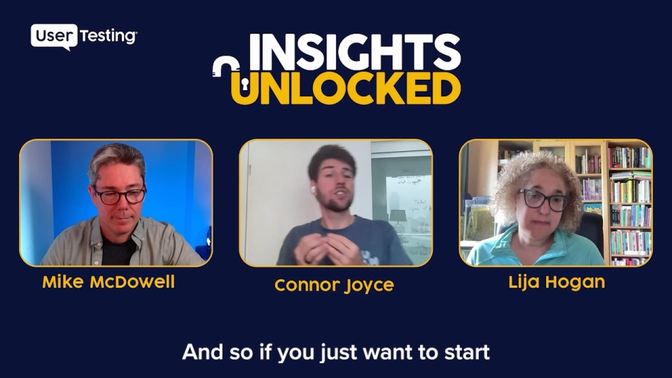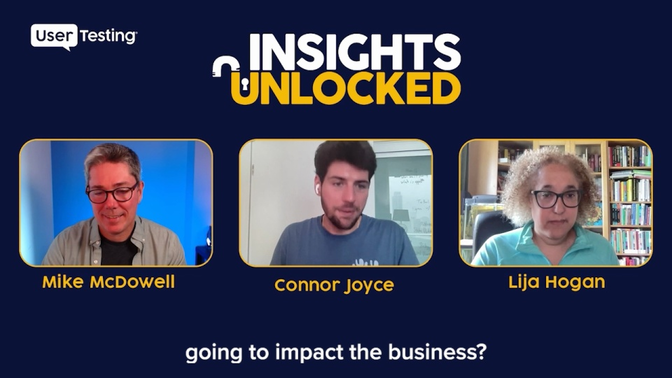
Episode 137 | September 23, 2024
How behavioral science drives user-centered product success
Discover how behavioral science can transform product development by shifting focus from outputs to meaningful user outcomes in this episode with Connor Joyce.
Why focusing on user outcomes, not outputs, is the future of product development
Behavioral scientist Connor Joyce says it’s a mistake when companies measure a product’s success by only tracking usage. Instead, he urges product teams to shift their focus from outputs to outcomes.
"Usage alone doesn’t mean a product is satisfying user outcomes," Connor says in this week’s Insights Unlocked. "The reality is, people don’t just use apps to use them—they’re trying to achieve something."
Connor, author of Bridging Intention to Impact, explains that many companies fall into the “output trap,” where success is defined by surface-level metrics such as clicks, retention, or user sessions. But those numbers don’t necessarily reflect whether a product is helping users meet their goals.
By regularly talking with your customers to better understand the problem you’re attempting to solve, your company will save money on development and rework costs; generate word-of-mouth buzz as customers share their positive stories with your product or service; and lay a foundation for long-term success.
The output trap: why metrics alone fall short
For many companies, success is measured by metrics like app usage, retention rates, and engagement. But according to Joyce, these outputs only tell part of the story.
"People use apps as tools to accomplish something," he said. Whether it’s improving fitness, saving money, or staying connected with loved ones, users have specific goals in mind when interacting with digital products.

Relying solely on outputs can mislead companies into thinking their products are performing well when, in reality, they might not be helping users accomplish their intended goals.
Shifting the focus to outcomes
So, how do companies shift their mindset from tracking outputs to focusing on outcomes? Joyce recommends looking at behavioral change as the true measure of success. The goal should be to create products that enable users to achieve what they set out to do, whether it’s training for a marathon or managing their finances more effectively.
"People are using apps as tools," Joyce says. "Interventions are the ways to tweak that usage in a way that makes it more effective."
By designing products that help users accomplish their goals, companies not only enhance user satisfaction but also create a more loyal customer base.
The role of behavioral science in product development
At the heart of Joyce’s philosophy is behavioral science, a field focused on understanding and influencing human behavior. He explains that product teams can leverage behavioral insights to create interventions that guide users toward desired outcomes.
"For me, I saw a natural combination of behavioral science and technology," says Joyce. "Behavioral science helps people make the change they want, and technology scales that change."

This approach involves continuously refining products based on user behaviors and outcomes, creating a feedback loop that ensures the product is always evolving to meet user needs.
Ethical considerations in product design
While designing for outcomes can be incredibly powerful, Joyce stresses the importance of doing so ethically. He notes that interventions should be designed to promote positive behaviors and avoid creating negative feedback loops that could harm users.
For instance, Joyce highlights the potential pitfalls in fitness apps, where extreme user engagement might lead to unhealthy behavior patterns, such as over-exercising. "It’s about ensuring that we’re promoting outcomes that are beneficial for users, not harmful."
How to get started: measuring outcomes instead of outputs
One of the most significant challenges product teams face is knowing where to start. Joyce suggests building a library of desired behaviors linked to user outcomes. For example, if an app’s goal is to help users improve their fitness, measurable outcomes might include the frequency of workouts or improvements in health metrics.
"By creating a body of behaviors that connect to the desired outcomes, teams can design features that encourage those behaviors," says Joyce. He also recommends using product analytics tools to measure whether these outcomes are being met, rather than just tracking surface-level engagement metrics.
Final thoughts
As Connor Joyce emphasizes throughout the podcast, focusing on user outcomes rather than outputs can transform how product teams think about success. By leveraging behavioral science and designing for meaningful change, companies can create products that drive lasting value for both users and the business.

"Ultimately, it’s about designing products that help people achieve what they’re really after—because that’s where true product success lies," Joyce concludes.
Episode Links:
- LinkedIn: Connect with Connor Joyce
- Book: Bridging Intention to Impact on Peach Pit
- Consulting: Desired Outcome Labs
- Behavioral science books like Nudge by Richard Thaler










